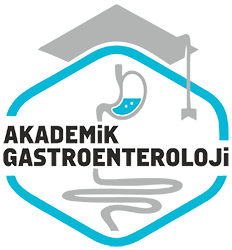Psödoksantoma Elastikum, hamile bir kadinda tekrarlayan üst gastrointestinal kanama nedeni
Pseudoxantoma Elasticum, as a repetitive upper gastrointestinal hemorrhage cause in a pregnant woman
- Ana Sayfa
- Sayılar
- Psödoksantoma Elastikum, hamile bir kadinda tekrarlayan üst gastrointestinal kanama nedeni...
Özet
Psödoksantoma elastikum nadir görülen; herediter, deri, göz, kardiovasküler sistemi etkiliyen bir multisistem hastalığıdir. Olgumuz, 28 yaşinda kadın hasta, üst gastrointestinal sistem kanaması şikayeti ile acil servise müracaat etti. Son 8 yılda on defadan fazla hematemezmelena şikayetleri ile gastroententeroloji kliniginde takip edilmiş olan hasta, öyküsünde daha önceki gebeliginde tekrar kanaması olduğunu ifade etmekteydi. Hastanın yapılan sistemik muayenesinde, gözde retina pigment epitelinde atrofi, fundusta angioid streaklar ve tipik peau d’orange bulgusu, OCT’de (optic coherans tomografi) retina sinir lifi tabakasinda incelme, boyun derisinde bilateral, retiküler tarzda sarimsi renkli, düz papüler lezyonlar (plucked chicken appearance), fundusda kanama odaklarinin olmasi ve böbreklerde nefrokalsinozis ile psödoksantoma elastikum tanısı aldi. Cilt biyopsisinde psödoksantoma elastikum saptandi. Psödoksantoma elastikum, nadir görülen ve genetik geçis gösteren sistemik bir hastalıktir. Psödoksantoma elastikum olgularina erken tanı konmasi, sistemik komplikasyonlarini erken tanımak ve yaşayan diğer aile bireylerinin genetik danisma almasi açısından önemlidir.
Abstract
Pseudoxanthoma elasticum is a rare, hereditary, multisystemic disease affecting skin, eyes, and the cardiovascular system. A 28-yearold female presented to the emergency unit with the complaint of gastrointestinal hemorrhage. Patient history revealed that she had been monitored in the gastroenterology clinic more than 10 times in the past 8 years, and had repetitive hemorrhage during her previous pregnancy. The examination of the patient revealed the following signs and symptoms: atrophy in the epithelium of the retina pigment; typical angioid streaks and peau d’orange finding in the fundus; thinning of the retinal nerve fiber in optic coherence tomography; bilateral and reticular papillary lesions with yellowish-color in the neck region (plucked chicken appearance); presence of bleeding foci in fundus; and nephrocalcinosis in kidneys. In light of these symptoms, the patient was diagnosed as pseudoxanthoma elasticum, which was also confirmed on skin biopsy. Pseudoxanthoma elasticum is an uncommon hereditary disease. Early diagnosis of pseudoxanthoma elasticum cases is important to minimize systemic complications and to inform the other family members through genetic counseling.



